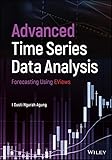Advanced time series data analysis : forecasting using EViews / I. Gusti Ngurah Agung.
Material type: TextPublication details: Hoboken, NJ : John Wiley & Sons, Inc., 2019; ©2019Description: 1 online resource (xvii, 520 pages)ISBN: 1119504732; 9781119504818; 1119504813; 9781119504740; 1119504740; 9781119504733Subject(s): Time-series analysis | Econometric models | MATHEMATICS / Applied | MATHEMATICS / Probability & Statistics / General | Econometric models | Time-series analysisOnline resources: Wiley Online Library
TextPublication details: Hoboken, NJ : John Wiley & Sons, Inc., 2019; ©2019Description: 1 online resource (xvii, 520 pages)ISBN: 1119504732; 9781119504818; 1119504813; 9781119504740; 1119504740; 9781119504733Subject(s): Time-series analysis | Econometric models | MATHEMATICS / Applied | MATHEMATICS / Probability & Statistics / General | Econometric models | Time-series analysisOnline resources: Wiley Online Library | Item type | Current library | Call number | Status | Date due | Barcode | Item holds |
|---|---|---|---|---|---|---|
 e-Books
e-Books
|
Central Library, Sikkim University | Not for loan | E-2898 |
Intro; Title Page; Copyright Page; Contents; About the Author; Preface; Chapter 1 Forecasting a Monthly Time Series; 1.1 Introduction; 1.2 Forecasting Using LV(p) Models; 1.2.1 Basic or Regular LV(p) Models; 1.2.2 Special LV(p) Models; 1.3 Forecasting Using the LVARMA(p,q,r) Model; 1.3.1 Special Notes on the ARMA Model; 1.3.2 Application of Special LVAR Models; 1.4 Forecasting Using TGARCH(a,b,c) Models; 1.4.1 Application of ARCH(a), GARCH(b), and TARCH(c) Models; 1.4.2 Application of TGARCH(a,b,0) Models; 1.4.3 Application of TGARCH(a,b,c) Models; 1.4.4 Other Alternative Models
1.5 Instrumental Variables Models1.5.1 Application of the GMM Estimation Method; 1.5.2 Application of the TSLS Estimation Method; 1.6 Special Notes and Comments on Residual Analysis; 1.6.1 Specific Residual Analysis; 1.6.2 Additional Special Notes and Comments; 1.6.3 Serial Correlation Tests; 1.7 Statistical Results Using Alternative Options; 1.7.1 Application of an Alternative Coefficient Covariance Matrix; 1.7.2 Application of Selected Combinations of Options; 1.7.3 Final Notes and Conclusions; Chapter 2 Forecasting with Time Predictors; 2.1 Introduction
2.2 Application of LV(p) Models of HS on MONTH by YEAR2.2.1 Special LV(12) Models of HS on MONTH by YEAR; 2.2.2 Application of the Omitted Variables Test -- Likelihood Ratio; 2.2.3 Heterogeneous Model of HS on HS(-12) and Month by YEAR; 2.3 Forecast Models of HS on MONTH by YEAR; 2.3.1 Application of LV(1) Models of HS on MONTH by YEAR; 2.3.2 Application of Basic LV(p) Models of HS on MONTH by YEAR; 2.3.3 Application of AR(q) Models of HS on MONTH by YEAR; 2.3.4 Application of ARMA(q,r) Models of HS on MONTH by YEAR; 2.3.5 Application of LVAR(p,q) Models of HS on MONTH by YEAR
2.3.6 Application of LVAR(p,q) Models of HS on YEAR by MONTH2.4 Heterogeneous Classical Growth Models; 2.4.1 Forecasting Based on LV(p) Het_CGMs of HS; 2.4.2 Forecasting Based on AR(q) Het_CGMs; 2.4.3 Forecasting Based on LVAR(p,q) Het_CGMs; 2.5 Forecast Models of G in Currency.wf1; 2.5.1 LVAR(p,q) Additive Models of G by @Month with @Trend; 2.5.2 LV(1) Heterogeneous Models of G by @Month; 2.6 Forecast Models of G on G(-1) and Polynomial Time Variables; 2.6.1 Heterogeneous Model of G on G(-1) and Polynomial T by @Month; 2.6.2 Forecast Model of G on G(-1) with Heterogeneous Polynomial Trend
2.7 Forecast Models of CURR in Currency.wf12.7.1 Developing Scatter Graphs with Regressions; 2.7.2 Additive Forecast Models of CURR with a Time Predictor; 2.7.3 Interaction Forecast Models of CURR; 2.7.4 Forecast Models Based on Subsamples; Chapter 3 Continuous Forecast Models; 3.1 Introduction; 3.2 Forecasting of FSPCOM; 3.2.1 Simple Continuous Models of FSPCOM; 3.2.2 LVAR(p,q) Models of Y = FSPCOM with Polynomial Trend; 3.2.3 Translog Models with Time Predictor; 3.3 Forecasting Based on Subsamples; 3.3.1 Lag Variable Models With Lower and Upper Bounds
Introduces the latest developments in forecasting in advanced quantitative data analysis This book presents advanced univariate multiple regressions, which can directly be used to forecast their dependent variables, evaluate their in-sample forecast values, and compute forecast values beyond the sample period. Various alternative multiple regressions models are presented based on a single time series, bivariate, and triple time-series, which are developed by taking into account specific growth patterns of each dependent variables, starting with the simplest model up to the most advanced model. Graphs of the observed scores and the forecast evaluation of each of the models are offered to show the worst and the best forecast models among each set of the models of a specific independent variable. Advanced Time Series Data Analysis: Forecasting Using EViews provides readers with a number of modern, advanced forecast models not featured in any other book. They include various interaction models, models with alternative trends (including the models with heterogeneous trends), and complete heterogeneous models for monthly time series, quarterly time series, and annually time series. Each of the models can be applied by all quantitative researchers. -Presents models that are all classroom tested -Contains real-life data samples -Contains over 350 equation specifications of various time series models -Contains over 200 illustrative examples with special notes and comments -Applicable for time series data of all quantitative studies Advanced Time Series Data Analysis: Forecasting Using EViews will appeal to researchers and practitioners in forecasting models, as well as those studying quantitative data analysis. It is suitable for those wishing to obtain a better knowledge and understanding on forecasting, specifically the uncertainty of forecast values.


There are no comments on this title.